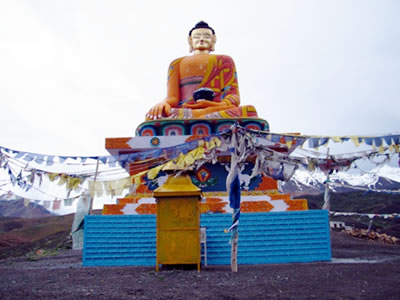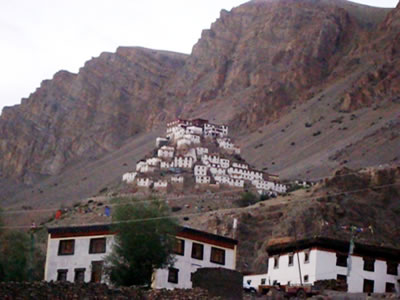Buddhist Monastic Tours
 |
 |
Himachal is situated in the western Himalayas. Covering an area of 55,673 kilometers, Himachal Pradesh is a mountainous state with elevation ranging from about 350 meters (1,148 ft) to 7,000 meters (22,966 ft) above the sea level. Buddhism of Himachal Pradesh can be traced back to the spread of Buddhism in the early 8th century. Over the centuries this activity has become deeper rooted, particularly in the Lahaul, Spiti and Kinnaur valleys.
After the 14th Dalai Lama, Tenzin Gyatso, escaped from Tibet with his followers in 1959 and took refuge in India, the focus on Tibetan Buddhism spread further and attracted immense international sympathy and support.
The Dalai Lama found Dharamshala in Himachal Pradesh as an ideal place to establish his “capital in exile” at McLeod Ganj in close vicinity to Dharamshala, and is called the Little Lhasa and also as Dhasa (a combination of Dharamshala and Lhasa in Tibet).
This situation has given the state a unique status in the global firmament of Buddhist traditions. It is now the cradle of Tibetan Buddhism, with its undeniable link to the past activities initiated in the 8th century (in 747 AD) by Guru Padmasambhava (who went to Tibet from Rewalsar in Himachal Pradesh in North India to spread Buddhism), who was known as the "Guru Rinpoche" and the “Second Buddha”.
The state boasts of a sizeable population of the followers of Buddhism. It is but natural for the region to have numerous Buddhists monasteries on its landscape.
Buddhist Monasteries in Himachal Pradesh
Lahaul & Spiti Lahaul Valley Guru Ghantal Monastery: - Guru Ghantal Monastery is situated on the right bank of Chandra River about 4 kms. above Tandi and is believed to be the oldest Gompa of Lahaul having wooden structure with pyramidal roofs, wood carving, preserving the idols of Padmasambhava and Brajeshwari Devi. On the full moon night in mid-June a festival called "GHANTAL" is celebrated by Lamas and Thakurs together.
Khardong Monastery: - Khardong Monastery is about 5 kms. from Keylong across Bhaga river. It is believed to be built in 12th century. This monastery has a large library of Kangyur and Tangyur volumes of Buddhist scriptures in Bhoti.
Shashur Monastery: - Shashur Monastery is situated on a hill about 3 kms from Keylong in Lahaul and Spiti district towards north. During June/ July this monastery attracts a large number of visitors when Lamas perform the devil dance. It was founded in the 17th century AD. It belongs to red hat sect and is located among the blue pines. The paintings represent the history of 84 Buddha’s.
Tayul Gompa: - Tayul Gompa is 6 kms. from Keylong in the Lahaul and Spiti district and is one of the oldest monasteries of the valley having a huge statue of Guru Padmasamhava about 5 m high and houses library of Kangyur having 101 volumes. In Tibetan language Ta-Yul means the chosen place.
Spiti Valley Kye Monastery: - Kye Monastery is situated 12 kms. North of Kaza in Spiti valley and serves the western population of Spiti. It is the oldest and biggest monastery of the valley and located above Kye village. It houses beautiful scriptures and paintings of Buddha and other goddesses. Lamas practice dance, sing and play on pipes and horns. Religious training to Lama's is imparted here.
Dhankar Monastery: - Dhankar Monastery is situated about 25 kms. East of Kaza and serves eastern part of central Spiti. Dhankar is a big village and erstwhile capital of Spiti King. On top of a hill there is a fort which used to be a prison in olden times. The Monastery has about 100 Lamas and is in position of Buddhist scriptures in Bhoti language. Principal figure is a Statue of "Vairochana" (Dhayan Buddha) consisting of 4 complete figures seated back to back. It has relics in the shape of paintings and sculpture.
Lhalung Monastery: - Lhalun Monastery or Lalung Monastery (also known as the Sarkhang or Golden Temple), one of the earliest monasteries (considered second to Tabo monastery in importance) founded in Spiti valley, near the Lingti river. It is dated to the late 10th century and credited to Rinchen Zangpo. Village of Lhalung (meaning: 'land of the gods').
Tabo Monastery: - Tabo Monastery is another large gompa serving the population of eastern side. It has its origin in the tenth century old and is located 50 kms. from Kaza in Lahaul and Spiti district. In fame it is next to Tholing Gompa in Tibet. It has about 60 Lamas and houses a large collection of Scriptures, wall paintings etc. Murals of this gompa have similarity to that of the Ajanta paintings
Kungri Gompa: - Kungri Gompa is situated in the Pin valley about 10 kms. from Attargo where Spiti river has to be crossed to enter Pin valley. It serves the population of Pin valley Kinnaur: - Nako: - The legendary footprints of the Guru Padamsambhava are enshrined at the Lotsabaage Monastery at Nako. This high altitude village in District Kinnaur is located near a limpid lake. Mandi: - Rewalsar is the most sacred spot for Buddhists in Himachal Pradesh, about 20 km south west of Mandi. According to legend, Guru Padmasambhava departed for Tibet from this beautiful spot, to spread the 'dharma'. A pagoda-style monastery stands along the edge of the lake.
Kangra Dharamshala:-
Tsuglagkhang :- An important Buddhist shrine (located opposite to the Namgyal Monastery in the same courtyard) in the town is the Tsuglagkhang or Tsuglag Khang, known as the Dalai Lama's temple. It houses the statues, in sitting postures, of Shakyamuni (gilded)- the central image, Avalokitesvara (the deity of compassion sculpted in silver with eleven faces and thousand arms and eyes -linked to a legend), and Padmasambhava (Guru Rinpoche) - both facing the direction of Tibet - and also the Tibetan Institute of Performing Arts.
Kalachakra Temple:- Kalachakra Temple is located adjoining the Tsulagkhang which is dedicated to the Kalachakra. The temple has fresco decorations of 722 deities of the mandala, Shakayamuni Buddha, and the central Kalachakra image.
Norbulingka Institute:- The Norbulingka Institute founded in 1988, by the present Dalai Lama has the primary objective of preserving the Tibetan language and cultural heritage. This institute has been patterned on the same lines as Norbulingka, the traditional summer residence of the Dalai Lamas, in Lhasa, amidst a well-maintained garden setting, and the emphasis here is more on traditional art. A temple named as the “Seat of Happiness Temple” (Deden Tsuglakhang) is located here. Around this temple, craft centre’s are located, which specialize in traditional forms of Thanka painting to Metal art that are considered integral to Tibetan Monastery architecture. 300 artisans work here and also impart training to their wards.
Tour Description: These routes are known as “Buddhist Circuit” of Himachal Pradesh about 12 small, big and ancient Monasteries come enrooted. Some Monasteries are more than one thousand years old. This route has different lush green valleys and cold desert landscapes.
- 8 Days Manali, Lahaul and Spiti Valley Tour, Enquire Now»
- 12 Days Shimla, Kinnaur, Spiti, Lahaul Valley and Manali Tour. Enquire Now»
- 12 Days Manali, Lahaul and Spiti Valley, Kinnaur and Shimla Tour.Enquire Now»
- 15 Days Dhramshala, Manali, Spiti and Lahaul Valley, Kinnaur and Shimla Tour.Enquire Now»






